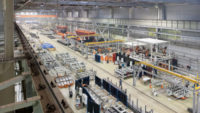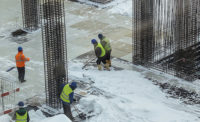Post-COVID-19 safety precautions for manufacturing facilities

Economies all over the world are ramping back up. It would be extremely premature to say that the pandemic is over, but even COVID-19 can’t keep the wheels of production still for long. The question is, can frontline workers in essential industries, like manufacturing, return to work with confidence?
It’s an employer’s responsibility to provide a work environment that’s as safe as possible — and not just because regulations say so.
COVID-19 presents several unique challenges for manufacturing environments. Billions of people around the globe depend on resilient supply chains and timely delivery of essential products. Shuttering plants indefinitely isn’t possible. How are manufacturers reopening with employee safety as the No. 1 priority?
Here are some precautions that need the manufacturing sector’s attention right now, as well as into the potential years-long “post-COVID world” many health professionals are predicting.
1. Provide protective products
The Centers for Disease Control and Prevention (CDC) recommends cleaning all shared or public surfaces before each use. This means workstations, breakrooms and restrooms need regular wipedowns.
Growing research shows that wearing masks can save lives, which means manufacturing companies must keep these essentials on hand throughout their facilities:
- Disposable masks and gloves
- Disinfecting wipes
- Hand sanitizer with 60% alcohol or greater
- Tissues and paper towels
2. Automate cleaning tasks
Floors are high-contact surfaces, but not a well-known vector for spreading coronavirus. What manufacturers and other industrial employers are finding, however, is that floors offer the ideal opportunity to deploy automated cleaning robots. Sales of these machines have grown substantially since the beginning of the outbreak.
Automating facility cleaning frees up maintenance crews to focus on high-touch surfaces, like shared areas and equipment. They have more time to tackle labor-intensive processes like treating or cleaning holding tanks or other mission-critical assets.
When it comes to the threat posed by the pandemic, humans are better equipped than robots to deal with the greatest risks to employees. Plus, keeping a more vigilant schedule overall with respect to basic cleaning, treatment and maintenance for industrial plants helps keep costs down and equipment in good condition.
3. Observe appropriate distances
Manufacturing, warehousing and distribution facilities may be big, but they’re still densely populated places. Social distancing rules under the pandemic say to maintain a distance of 6 to 10 feet at all times.
For many employers, it could be a challenge to observe these practices without decimating productivity. Here are some ideas to keep employees safe without unnecessary impact to travel time or productivity:
- Storage and warehousing locations may require new signage to indicate safer, one-way traffic in and out of the area.
- Plexiglass shields between workstations may contain the spread of contagion.
- Workstations should also be moved or reconfigured so employees on the line can carry out their functions and exchange workpieces without close contact. Additional conveyors and material handling products may help.
- Many manufacturers are having luck with autonomous systems like AGVs (automated guided vehicles). These move materials and parts between stations with limited employee intervention, contact and travel.
4. Stagger shift start times
The meat and poultry processing industry is one that the CDC singled out specifically with a set of best practices and safety precautions. These recommendations are similar to guidelines for other manufacturing industries, and they’ve been drawn up for employer liability and worker well-being alike.
One of the recommendations that applies to manufacturers in general is the practice of staggering shift times throughout the day. This helps avoid congestion at entrances and time clocks, and therefore the kind of close, prolonged exposure that can easily spread the virus.
If this isn’t realistic, it’s important to think about how and when traffic flows through your facility. Placing additional time clocks or implementing touchless “punching in” could set everyone's minds at ease.
5. Implement pre-shift screening
According to guidance from the Equal Employment Opportunity Commission (EEOC) and other bodies, pre-shift screening for coronavirus symptoms is a lawful precaution to take. This does not cover examinations or questions about any other medical conditions.
Pre-shift screening can help flatten the curve. It typically involves asking workers whether they’ve experienced COVID-19 symptoms in the last 24 hours and could include taking their temperature to weed out any fevers.
It’s not a perfect system, as asymptomatic individuals can still pass the virus along. The practice may not have to last long to be useful, however. It gets employees in the habit of being mindful of their own bodies and screening themselves for symptoms without being prompted.
6. Implement paid sick leave
Paid sick leave is the obvious next conversation item after pre-shift checkpoints, self-screening and self-isolation under the suspicion of COVID-19 symptoms.
The U.S. came close in the 1940s to implementing a worker-focused Second Bill of Rights. It would have guaranteed “adequate protection from the economic fears of old age, sickness, accident and unemployment.” Other nations have taken up these ideas in the meantime.
COVID-19 has reignited interest in more universal provisions for paid sick leave in the U.S. Epidemiologists predict that the economic fallout of coronavirus will disproportionately impact minority, low-income and even some middle-income wage earners. These individuals are less likely to be able to afford to self-isolate if they discover they have symptoms.
Manufacturers play a key role in the global economy, which means their workers do, too. Employees should know somebody has their back if they must put their life on hold to deal with or avoid a dangerous illness.
7. Assign leaders and have a plan
There’s no question that daily life will have to change under your roof for operations to continue mostly as they were before the pandemic.
This means employers need thought leaders who know the departments and processes and who can “own” the transition. They’ll answer employee and stakeholder questions, as well as devise, implement and test procedural changes. They can make further alterations as the business spins back up again and sees how things go under the new normal.
These “transition czars” should be able to answer questions like:
- Which procedures are changing or being added?
- What is the level of risk in each process?
- How will these changes get rolled out, and what is the timeline?
- Who is responsible for implementation?
- How will the employer maintain confidentiality for employee health matters?
- Is there a workflow in place for process improvements after reopening, or for reordering essential products like cleaning supplies and PPE?
Employers must develop and explain the procedure that workers should follow to isolate themselves and inform their managers if they suspect they’re falling ill. This might mean it’s a good idea to invest in new initiatives to reskill employees or build new talent pipelines.
Manufacturers can weather storm
With these precautions, manufacturers should be able to get back up to speed while keeping health as their top priority. Workers look to this community for their livelihoods and sense of stability, and they deserve to carry out their essential work in safety and confidence.
Looking for a reprint of this article?
From high-res PDFs to custom plaques, order your copy today!








